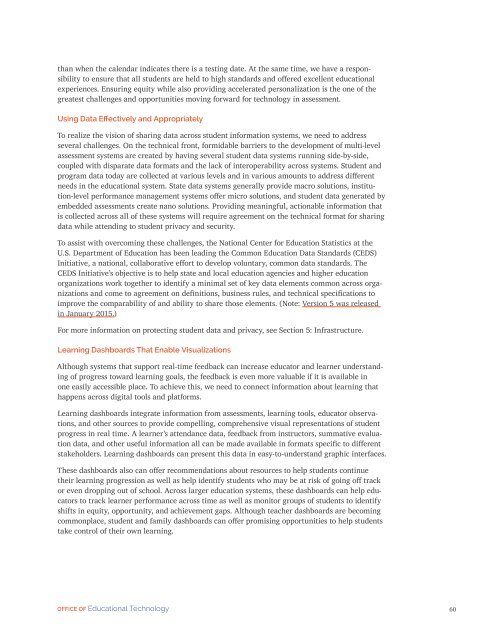Future Ready Learning
7m3sdJ
7m3sdJ
Create successful ePaper yourself
Turn your PDF publications into a flip-book with our unique Google optimized e-Paper software.
than when the calendar indicates there is a testing date. At the same time, we have a responsibility<br />
to ensure that all students are held to high standards and offered excellent educational<br />
experiences. Ensuring equity while also providing accelerated personalization is the one of the<br />
greatest challenges and opportunities moving forward for technology in assessment.<br />
Using Data Effectively and Appropriately<br />
To realize the vision of sharing data across student information systems, we need to address<br />
several challenges. On the technical front, formidable barriers to the development of multi-level<br />
assessment systems are created by having several student data systems running side-by-side,<br />
coupled with disparate data formats and the lack of interoperability across systems. Student and<br />
program data today are collected at various levels and in various amounts to address different<br />
needs in the educational system. State data systems generally provide macro solutions, institution-level<br />
performance management systems offer micro solutions, and student data generated by<br />
embedded assessments create nano solutions. Providing meaningful, actionable information that<br />
is collected across all of these systems will require agreement on the technical format for sharing<br />
data while attending to student privacy and security.<br />
To assist with overcoming these challenges, the National Center for Education Statistics at the<br />
U.S. Department of Education has been leading the Common Education Data Standards (CEDS)<br />
Initiative, a national, collaborative effort to develop voluntary, common data standards. The<br />
CEDS Initiative’s objective is to help state and local education agencies and higher education<br />
organizations work together to identify a minimal set of key data elements common across organizations<br />
and come to agreement on definitions, business rules, and technical specifications to<br />
improve the comparability of and ability to share those elements. (Note: Version 5 was released<br />
in January 2015.)<br />
For more information on protecting student data and privacy, see Section 5: Infrastructure.<br />
<strong>Learning</strong> Dashboards That Enable Visualizations<br />
Although systems that support real-time feedback can increase educator and learner understanding<br />
of progress toward learning goals, the feedback is even more valuable if it is available in<br />
one easily accessible place. To achieve this, we need to connect information about learning that<br />
happens across digital tools and platforms.<br />
<strong>Learning</strong> dashboards integrate information from assessments, learning tools, educator observations,<br />
and other sources to provide compelling, comprehensive visual representations of student<br />
progress in real time. A learner’s attendance data, feedback from instructors, summative evaluation<br />
data, and other useful information all can be made available in formats specific to different<br />
stakeholders. <strong>Learning</strong> dashboards can present this data in easy-to-understand graphic interfaces.<br />
These dashboards also can offer recommendations about resources to help students continue<br />
their learning progression as well as help identify students who may be at risk of going off track<br />
or even dropping out of school. Across larger education systems, these dashboards can help educators<br />
to track learner performance across time as well as monitor groups of students to identify<br />
shifts in equity, opportunity, and achievement gaps. Although teacher dashboards are becoming<br />
commonplace, student and family dashboards can offer promising opportunities to help students<br />
take control of their own learning.<br />
OFFICE OF Educational Technology<br />
60



